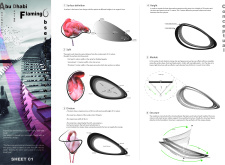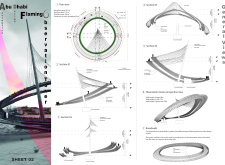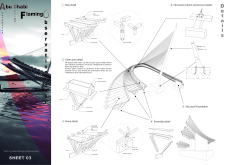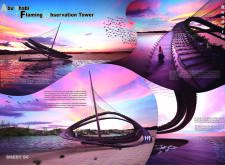5 key facts about this project
The project represents a blend of ecological awareness and architectural innovation. Its design draws inspiration from the forms of flamingos, paralleling their elegant silhouette within its structural language. The tower integrates seamlessly into the landscape, enhancing the user experience through thoughtful accessibility features. The ramp, designed at a width of two meters for accommodating individuals with disabilities, ascends to an observation height of ten meters, while stairs allow visitors to reach an elevation of twelve meters. Such features emphasize inclusive design, ensuring all visitors can engage with the environmental context comfortably.
Unique Design Approaches
The Flamingo Observation Tower employs a parametric design methodology that results in a form responsive to both environmental and functional requirements. This design technique facilitates the creation of an organic structure that minimizes its ecological footprint while maximizing visitor interaction with views of wildlife. The structure’s five distinct points, which vary in height, contribute to its dynamic profile while ensuring structural integrity through a network of columns and tension cables.
Sustainability is core to the design ethos of the project. Materials such as concrete and steel are utilized strategically, with concrete forming a sturdy foundation and steel creating a lightweight framework. The design also incorporates wood for aesthetic elements and possible landscaping features, aligning with the natural materials of the surrounding habitat. This careful selection of materials reinforces both the sustainability goals and the visual coherence with the environment.
User Experience and Interaction
The tower's design encourages interaction with the natural landscape, promoting engagement through features like boardwalks that connect visitors with the water's edge. These pathways ensure accessibility while reducing ecological disturbances in sensitive areas. Furthermore, the community engagement aspect is pronounced; visitors are invited to participate in plantings, fostering a sense of stewardship and connection to the project.
The architectural plans and sections illustrate the innovative use of space and material, offering further insights into the design intricacies. Review these elements to explore how the Flamingo Observation Tower presents a compelling case study in contemporary architecture that balances user experience with environmental integrity.


























